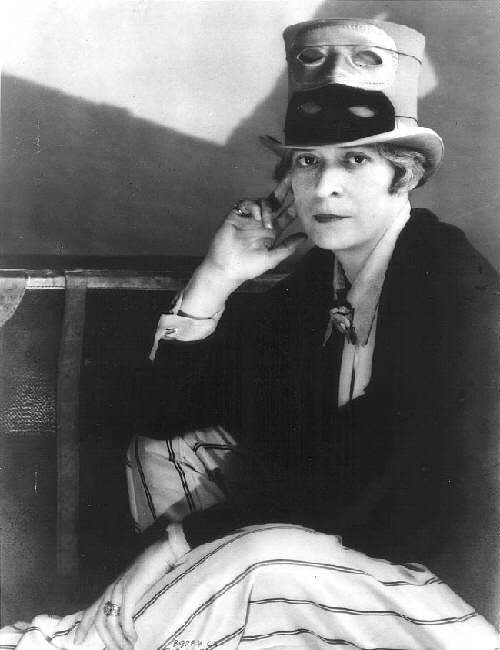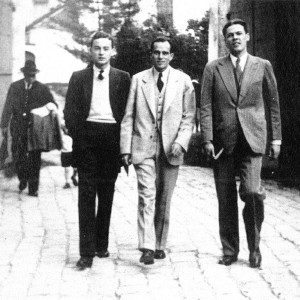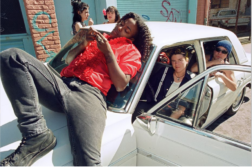THE INTERWAR YEARS, from the Armistice of 1918 until Pearl Harbor, were fertile for cultural productivity in New York City. Gay men and lesbians were at the heart of accomplishments in the literature, music, and dance of the period. And their creativity only increased after World War II in the new arena of mass entertainment. Associations among well-connected gay men allowed the Cold War era, however censorious and politically fraught, to be a golden age of gay influence on American popular culture. The waggish term “Homintern” was an ironic rejoinder to the more nefarious “Comintern” denoting evil Soviet sway on American life, only now it referred to a cabal of homosexual power brokers in the arts. Significantly, the Big Apple was the seat of transatlantic queer cultural ascendancy in these decades, none of which translated into gay political power at the time. But cultural activity helped create community—and may have been a precondition for the activism that emerged later.
Let us first acknowledge what seems in retrospect a mass exodus to Paris among creative Americans in the 1920s. Homegrown lesbian expatriates nearly single-handedly put the “modern” in literature, most famously Gertrude Stein, whose Left Bank influence predated this period. In the 1920s, lesbian American expatriate Sylvia Beach, owner of the Left Bank bookstore and lending library Shakespeare & Company, published James Joyce’s Ulysses even though its (hetero)sexual content was widely regarded as obscene. Meanwhile, bi-continental figures like Margaret Anderson and her lover Jane Heap—in their influential literary journal The Little Review, located for some time in New York City—published key gay and lesbian poets and writers, including H.D. (Hilda Doolittle), Hart Crane, Gertrude Stein, and Jean Cocteau, along with some major non-gay writers. In 1918, for example, The Little Review serialized selections from Ulysses—as thanks for which the publishers stood trial on obscenity charges brought by the New York Society for the Prevention of Vice. In 1920, the verdict went against Anderson and Heap, and they were fined $100; the episode helped secure their reputations.

Jane Heap—mannish in dress and demeanor and revered by Anderson as “the world’s best talker”—also ran The Little Review Gallery in New York. In 1927 she organized a large “Machine Age Exposition” that brought together the work of international architects, engineers, sculptors, painters, photographers, and the like, confirming the new confluence of art and industry. Another transatlantic lesbian, the redoubtable Janet Flanner, wrote her famous “Letter from Paris” for The New Yorker under the sexually ambiguous nom de plume Genêt. With her personal reportage on the Paris scene, she helped establish The New Yorker as both a signifier of New York sophistication and herself as a crucial link between culturally astute New Yorkers and the expatriate American community inhabiting Montparnasse and other Left Bank locales.
Thus 1920s homosexual creativity and cultural influence did not belong exclusively to Paris, but was shared. Much credit for creating congenial New York spaces in which gays and lesbians flourished, networked, and shared social and professional support goes to the boundary-breaking salons of the mandarin left-wing eccentric Muriel Draper and the more upper-crust married couple Kurt and Constance Askew. In midtown, Draper brought together what became known as Upper Bohemia, an incongruous assortment that included, in the words of Steven Watson in Prepare for Saints, “working-class laborers and body builders as well as London aristocrats and Parisian trendsetters, artists and writers, opera singers and cabaret performers, socialist organizers and Gurdjieff disciples.” According to Draper’s son Paul, in his mother’s salon “there were perhaps more homosexuals per room than anywhere.” At her twice weekly afternoon teas, she presided from a gilt “throne” while her homosexual guests’ “topics of conversation included Proust, Picasso, antique furniture, and the newest color schemes.” Gay or bisexual notables present included the composer, music critic, and waspish commentator Virgil Thomson; composer and portrait photographer Max Ewing; and, still in their formative years, photographer George Platt Lynes and arts powerbroker Lincoln Kirstein.
The young Kirstein, not yet America’s major ballet and cultural impresario, was already a force at Harvard, where he cofounded the Society for Contemporary Art, precursor to New York’s Museum of Modern Art, as well as the avant-garde literary magazine Hound and Horn. About half the age of his hostess, Kirstein was taken to her bed and mentored by Draper, but this hardly established him as fully heterosexual. His taste in men often ran to heroic proletarian types encountered in waterfront bars. Kirstein, inspired by Diaghilev’s example, would bring Russian choreographer George Balanchine to America in 1933 and sponsor the School of American Ballet, which would by 1948 develop into the New York City Ballet, the jewel in the crown of American classical dance.
A young and handsome fledgling publisher of recherché literary texts, George Platt Lynes—who later became one of New York’s pre-eminent celebrity and fashion photographers—was in the later 1920s another ambitious devotee of Muriel Draper (just as he’d been a teenage acolyte of Gertrude Stein on his first trip to Paris in 1925). In New York, Lynes brought to Draper’s attention a Yiddish translation of Stein’s playfully imperious text “Descriptions of Literature,” full of gnomic maxims about the art of writing, which he had first published in English through his As Stable Publications. Draper had the Yiddish text read aloud to her guests, which probably did not illuminate Stein’s thinking but did call to mind her experimental writing techniques for the New York cognoscenti.

Lynes, coincidentally, had attended the Berkshire School, the same prep school as Kirstein attended. As they renewed their acquaintance, Lynes was invited to document Balanchine’s choreography and that of others under the Kirstein umbrella. Lynes’ photographs are important documents of “Mr. B’s” early American work. They also commemorate male dancers of the pre- and postwar eras, some of whom were icons to an appreciative gay audience, including Lew Christensen, Erik Bruhn, Francisco Moncion, Nicholas Magallanes, and Jacques d’Amboise. Even during the Cold War’s “Lavender Scare,” the New York ballet world was a safe space in which gay sensibilities were more honored than distrusted.
Lynes was also gaze-worthy for the unusual domestic life he shared with book designer Monroe Wheeler and his life companion, novelist and poet Glenway Wescott (The Pilgrim Hawk; Apartment in Athens). Wheeler and Wescott had joined the gay and lesbian “sexpatriates” of 1920s Paris and the south of France. Lynes first met them in 1927 in New York, immediately falling in love with Wheeler. Wescott in the late ’20s was considered a major literary figure alongside Hemingway and Fitzgerald. (For a more complete summary of Wescott’s life and career, see my article, “Glenway Wescott’s World,” in this magazine’s May-June 2014 issue.) Wheeler published beautiful deluxe editions of classic and contemporary literature.
Once all three had settled in together in New York City in 1934, Wheeler established an important career as a book and catalogue designer for the Museum of Modern Art, eventually becoming its lead exhibition designer. When the three were a domestic trio, their dinner parties included guests from society and notables from the arts; their close writer friends included Cocteau, Thornton Wilder, Somerset Maugham, Katherine Anne Porter, and Marianne Moore—a pretty queer lot, with the exception of Porter.
When Lynes ended their ménage in 1943 to go his own way, he introduced many a young gay man into “the life” through his wide-ranging contacts in dance and the visual arts, including close associations with painters Paul Cadmus, Jared French, and George Tooker—a remarkable trio of gay artists who kept alive the classical homoerotic tradition of the male figure at a time when abstraction in the New York art world was de rigueur.
The Askew salon, active in a brownstone along East 61st Street, was a tonier setting than Draper’s and had a formalwear dress code. Although the Sunday 5 o’clock gatherings were known as “teas,” what was imbibed was bootleg liquor served as cocktails, which accounts for the Prohibition Era joke that guests were frequenting the Askew Saloon. Those in attendance were a mixture of the emerging and the established: art historians Henry-Russell Hitchcock and Erwin Panofsky; gallerists Pierre Matisse and Julien Levy; and young museum professionals like A. Everett “Chick” Austin from Hartford’s Wadsworth Athenaeum and Alfred Barr from New York’s Museum of Modern Art. Among emerging gay talents were composer Aaron Copland, architect Philip Johnson, and fashion photographer George Hoyningen-Huene.
The attractive young Askews were relaxed enough to permit male couples to attend the salon together; these included Glenway Wescott with Monroe Wheeler and composer Virgil Thomson with painter Maurice Grosser, but, according to Steven Watson, “those whose liaisons cut across class rarely appeared with their working-class companions.” Married “straight” couples in attendance often included husbands with homosexual tastes, and these Virgil Thomson called “queer marriages”: among them, Lincoln Kirstein and Fidelma Cadmus—sister of Paul Cadmus; composer-writer Paul Bowles and his writer wife, Jane Bowles; photographer-writer and promoter of the Harlem Renaissance Carl Van Vechten with his wife Fania Marinoff; and composer Marc Blitzstein (The Cradle Will Rock) and Eva Goldbeck. Chick and Helen Austin could be added to this list, as could the host and hostess, the Askews themselves. Concludes Watson: “The fact that many of the Askews’ male guests were homosexual or bisexual was not a secret, but alluding to homosexuality was bad form.” And Virgil Thomson said, “You did not camp at the Askews. If you rubbed their noses in it, you weren’t going to be asked around.”
When the Gertrude Stein-Virgil Thomson opera Four Saints in Three Acts was in preparation for its 1934 premiere at Austin’s Wadsworth Athenaeum, Thomson and the gay English ballet choreographer Frederick Ashton lived in the Askews’ brownstone. Their cast was entirely African-American, with Ashton recruiting his dancers from Harlem’s Savoy Ballroom. Such casting was especially original in that the opera had nothing to do with race and it represented the first time an all-black cast had performed an opera for a white audience. Indeed, claims Watson, “the opera’s casting represented the apotheosis of the period’s Negro chic.” The play’s success in Hartford was followed by a hugely successful transfer to Broadway, prompting Macy’s department store to advertise its fall line as “Four Suits in Three Acts.”
Harlem was New York’s African-American stronghold but was also a lively site for gay life. By the 1920s, “Negrophilia” had white gays and sophisticated straights making Harlem a destination for its famous drag balls at the Hamilton Lodge, which drew thousands of spectators, and for nightclubs featuring gay and lesbian entertainers—singers like Alberta Hunter and Gladys Bentley, a “bulldagger” in top hat and tails, and the renowned Jimmie Daniels, who sang Gershwin and Cole Porter. Boyishly handsome with a smile that could charm the birds out of the trees, he was photographed by both George Platt Lynes and Carl van Vechten. The Harlem Renaissance also saw a major flowering of African-American literature, and several of its poets and novelists, such as Countee Cullen, Bruce Nugent, and Langston Hughes, were either gay or bisexual with varying degrees of openness.
World War II expanded the lesbian and gay community by bringing American youths in uniform into major port cities, where queer meeting places were sprouting—especially in New York. Although the 1943 ballet Fancy Free, about three sailors on leave in the Big Apple seeking female companionship, was not thematically gay, its choreographer, Jerome Robbins, and its composer, Leonard Bernstein, were very much a part of New York’s gay cultural circles. Bernstein, the concert hall wunderkind, was mentored by Aaron Copland, a gay father figure. Marc Blitzstein, married but homosexual, was another influence and model to the handsome young Bernstein. Together, Robbins and Bernstein eventually created the postwar era’s most successful Broadway dance musical, West Side Story, whose other collaborators—book writer Arthur Laurents and librettist Stephen Sondheim—were likewise members of the illusory “Homintern.” Nor can we forget that, on the dramatic Broadway stage, Tennessee Williams’ work was testing the indirect inclusion of homosexual themes in A Streetcar Named Desire and Cat on a Hot Tin Roof.
By then, Dr. Alfred Kinsey’s reporting on Sexual Behavior in the Human Male had made a dent in heterosexual hegemony. New York, the capital of American publishing, would find in the postwar era that fiction writers were similarly breaking the silence on queer lives: Gore Vidal, Truman Capote, and James Baldwin, in their writing and their self-presentation, suggested a masculinity at odds with the World War II machismo of writers like James Jones and Norman Mailer. The works of Vidal, Capote, and Baldwin became necessary reading for New Yorkers whose cultural tendencies were trending progressive with the downfall of Joseph McCarthy and the birth of the Beats—including the eminently gay Allen Ginsberg.
Of course, as decades go the ’50s could hardly be called politically progressive; gays and lesbians who labored in the culture factory were mostly still in the closet. Yet within their own privileged circles, and to those “in the know” in New York, the long-established and continuing cultural productivity of “their kind” kept alive a sense that one was not alone. A cultural community of overlapping networks and mutual support was being built and the seeds of political revolt were being planted for the next generation to sow.
References
George Chauncey, Gay New York: Gender, Urban Culture, and the Making of the Gay Male World 1890-1940. Basic Books, 1994.
Julie Kavanaugh, Secret Muses: The Life Frederick Ashton. Pantheon, 1996.
James R. Mellow, Charmed Circle: Gertrude Stein & Company. Praeger, 1974.
Steven Watson, Prepare for Saints: Gertrude Stein, Virgil Thomson, and the Mainstreaming of American Modernism. Random House, 1998.
Allen Ellenzweig is the author of The Homoerotic Photograph and a frequent contributor to this magazine.






